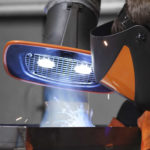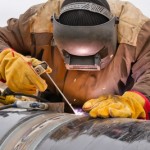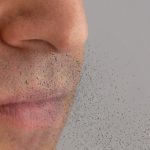Air return system for chrome-nickel welding works: the welding fumes separation class matters
Air return system through the extraction devices during chrome-nickel-steel welding works? In Germany the answer is clearly yes! At least as long as the extraction and filtering devices have the appropriate welding fumes separation class. Whereas the dust class is playing a subordinate role. However, a complete air return system for the whole room is legally impossible.
Chrome-nickel-steels produce the most dangerous and harmful substance particles that the welders may inhale during the welding works. If they are regularly exposed for the chrome-nickel welding fumes, they are threatened with health risks including cancer diseases. Therefore it is compulsory for the metal processing workers to extract the fumes at the source. However, although it is obvious that after filtering the particles that emerge for example during welding the construction steels the air returns to the hall, the metal processing workers are still asking, whether the air with all the highly hazardous substances may be returned to the hall at all?
And the answer is clearly yes. The extraction and filtering systems are nowadays capable of purifying the contaminated air to such an extend that this air may again be used as breathing air. But what is important during this process? The applied filtering device is playing a significant role here. Against some opinions, the filter class of the applied filter element, divided into L, M and H, is not the only decisive factor. When it comes to the chrome-nickel problems, it is only crucial that the extraction and filtering device will have the appropriate welding fumes separation class.
Filter class also has a say when it comes to the welding fumes separation class
 In order to separate the particles from the air during the welding works of chrome-nickel-steel and to be able to return them to the hall, the whole device must be tested in accordance with the welding fumes separation class W2 or W3. A device is for sure not going to receive a W3 certificate if it only has the lowest filter class L. So here the filter classes are coming into play again.
In order to separate the particles from the air during the welding works of chrome-nickel-steel and to be able to return them to the hall, the whole device must be tested in accordance with the welding fumes separation class W2 or W3. A device is for sure not going to receive a W3 certificate if it only has the lowest filter class L. So here the filter classes are coming into play again.
Whether W2 class will be enough or whether W3 class will be required, this depends above all on the alloy percentage of the materials processed. The manufacturers usually request a W3 certification to be on the safe side. What distinguishes W3 class is an extremely high separation level. More than 99% of particles must be separated from the air – because it must be statistically sure that this value will be met, during the examination the device must show a significantly higher value. In order to be granted the W3 certification an IFA-inspection is also necessary.
Complete air return is not allowed in some cases
An air return is only possible in Germany when certain restrictions will be met. During the work with carcinogenic substances that emerge during the chrome-nickel-steel welding works the percentage of the returned air may only constitute 50% of the total air returned. This is stipulated in the provisions of VDI 2262 page 3 and BGR 121. But this value not only refers to the device itself, but also to the whole room. So if there are also other devices / systems in the hall that guarantee the required external air percentage, the whole air volume of the W3 certified device may be returned.





